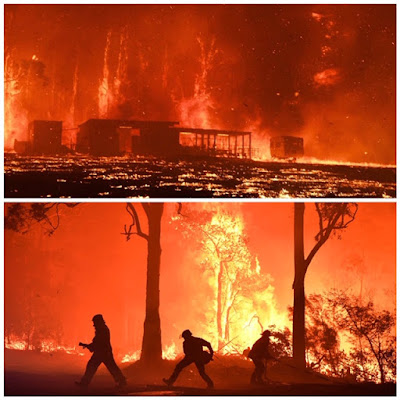But then in January things changed and we have had some brutal summer weather, particularly in the southern part of the country, since then. The states of South Australia and Victoria have had days on end of 40deg C plus (104deg F) temperatures.
On Saturday 7th February in Melbourne it was almost 47deg C (116 deg F ) with 100km/hr (60mph) winds.
This weather brought with it the inevitable bush fires.

It was a disastrous day in Victoria with 209 now confirmed dead with the number expected to rise, with some estimates as high as 300. Many others are critically injured and there has been a huge loss of property including over 1800 homes. Some towns have been completely razed.
455,000 hectares have been burnt with devastating affect on wildlife and livestock.
We have so far been bush fire free in our local area. Temperatures have been in the high 30's but we have so far been blessed with sea breezes to take the edge off things. But there is a huge fire a few hundred kilometers to the south west of us that has been burning in inaccessible country for some weeks now.
South Coast NSW Update (13/2/09): We had a mild southerly change around 6pm on Sunday 8th February. Temperatures dropped by 10C and humidity rose.
It's now cool and humid with quite heavy occasional showers tending to rain.
The fire to the south west of us at Belowra is still burning but conditions are benign and have slowed the spread of the fire. We are in no immediate danger.
 (click on above pic for more bushfire photos)
(click on above pic for more bushfire photos)Meanwhile in Queensland torrential rain over an extended period has caused disastrous flooding, the worst in 30 years. In some areas it has been raining 40 days and 40 nights. It is now estimated that 60% of the state, about six times the size of Texas, is under water.
Australia is certainly a country of extremes.
A History of Bushfires in Australia.
Dec 30, 2007 - Blaze kills three truckers on a highway near Coolgardie in WA.
Jan 2006 - Three deaths and multi-million-dollar stock and property losses in 10 days of bushfires in Victoria.
Jan 11, 2005 - Nine lives lost in South Australian Eyre Peninsula bushfires.
Dec 2003 - Two women die as they try to outrun flames near Tenterden, 350km south-east of Perth.
Jan 18, 2003 - Four people die and almost 500 homes are razed in a massive firestorm in Canberra.
Dec 2002 - Two men die and more than 20 homes lost in bushfires that spread from rural NSW to ring Sydney.
Dec 2, 1998 - Bushfire claims five firefighters at Linton in Victoria. Dec 2, 1997 - Two die in bushfires at Lithgow in NSW.
Jan 21, 1997 - Three people die and 33 homes destroyed in bushfires that ravaged the Dandenong Ranges on Melbourne's eastern outskirts.
Jan 1994 - Four die, 200 properties lost, several hundred people injured as bushfires from rural NSW descend on Sydney.
Feb 16, 1983 - Ash Wednesday bushfires in Victoria and South Australia claim 76 people.
Jan 8, 1969 - 23 people die in grassfires in Victoria across townships including Lara, Daylesford, Dulgana, Yea, Darraweit, Kangaroo Flat and Korongvale.
Feb 7, 1967 - Bushfires kill 59 people in southern Tasmania.
Jan 13, 1939 - Black Friday bushfires in Victoria kill 71 people and destroy several towns across 20,000 square kilometres of burnt land.
.
Multi Media:
.
Photos:
.
Interview with a survivor (audio/slideshow):
-
Pictures in this entry come from the Sydney Morning Herald Newspaper (8/2/09 and 11/2/09 editions).





























